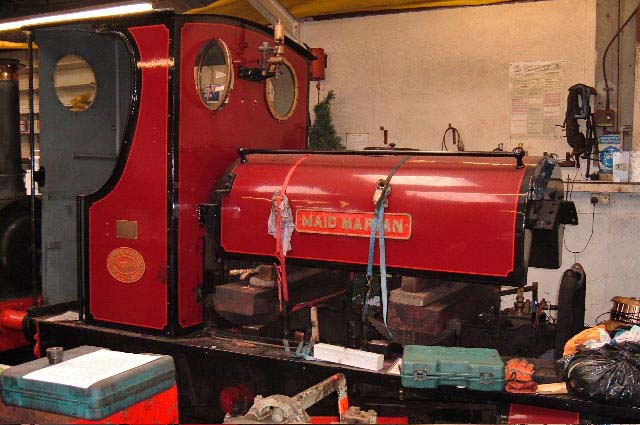

Hunslet 0-4-0 Alice has just completed firing up in the morning ready for the first train of the day - Date unknown John Bowers.
1 July 2005 The Bala Lake Railway In 1868 a standard gauge passenger line was built between Bala and Dolgellau in Wales, as part of the British national rail network, and formed part of Great Western Railways after 1877. Following closure due to the Beeching Axe in 1965, the service to the public ended and the standard gauge track was lifted.
In 1971 a local engineer called George Barnes saw the opportunity for a tourist line, and the Bala Lake Railway Ltd. company was formed with freight rolling stock arriving first to deal with the task of rebuilding the right-of-way to a 2 foot (Actually 1 foot 11 1/2 inches) narrow gauge. The railway first opened to the public in 1972 with an initial line length of 1 1/4 miles. The line has subsequently been extended in stages to 4 1/2 miles running along the eastern shore of Bala Lake.
Bala Lake is the largest natural lake in Wales, and the railway has its main terminus and engine sheds at the southern end of the line, at Llanuwchllyn. The station at Bala is unmanned and has a waiting room only, as you buy tickets on the train. At Llanuwchllyn the station buildings are original, dating from 1896, although the main building has since been extended.
The railway employs Hunslet quarry steam locos for motive power, together with more modern diesels. Some loco maintenance and construction is done at Llanuwchllyn, although major work is carried out off-site at places such as the Talyllyn Railway.
On arrival at Llanuwchllyn, I walked to the shed. The loco in operation on the day of my visit was "Alice", with an open cab. She was built in 1902 with works number 780, and easily hauled a rake of four bogie coaches, due to the level gradient. She was purchased after 1960 from a quarry, as a source of spare parts by a Methodist minister, also the then owner of Hunslet "Holy War" no. 779. "Alice" only started steaming again in 1994 after passing through various owners since the 1960s.
It is increasingly rare to have access to an engine shed, but the members of the railway kindly allowed me to enter the shed and photograph inside. As I exited and took the above picture, they warned me that I might want to move, as they were about to drain the cylinders!
After leaving the shed and reversing onto the main track, "Alice" ran round the train for coal and water. Coaling is done manually, which is not inconvenient due to the small size of the loco. Following servicing, she ran back to the front of the train and was coupled up.
After the train left I walked along the platform and visited the signal box, which is also the original dating back to 1896.
The Bala Lake railway carries out regular maintenance of the right-of-way, and deals with fallen branches and any damage caused by flooding.
After the train departed I followed it by road to the mid point station at Llangower. There are three interim stations along the line. The train traveled faster than anticipated and I only just caught it at Llangower station.
As stated, the station to the east of Bala town is unmanned with only a small waiting room. Visitors are therefore recommended to visit the railway at Llanuwchllyn, where there are more facilities and a car park. Bala station is about 1/2 a mile to the town, but only a short walk to the lake.
After the train arrived at Bala, the loco detached and ran round the train to couple up for the return run south. A few people were waiting for the train at Bala and I was able to answer a few of their questions regarding the route, tickets, etc. A member of their party would also follow the train by car, to meet them at the other end.
A one way journey on the line takes about 25 minutes, with a return trip taking up to 1 and 1/2 hours depending on the direction of travel. The railway has nine passenger coaches available, constructed during 1972 or after, with 2 "toast rack" open coaches and some windowless coaches.
Inside the engine shed was stabled "Holy War". This topically named Hunslet quarry locomotive with works no. 779 was purchased from its private owner in 1989 by the railway and carries a blue livery.
"Maid Marian" was built in 1903, and is an 0-4-0ST Hunslet as are the other two locomotives. She ended her quarry working life in 1964 when she was bought for preservation by steam enthusiasts. She presently needs a new boiler and is stored out of service in the shed. Prior to this red livery she wore a black colour scheme.
On the second shed road was stored the frame and some parts for "George B", on a works trolley. This locomotive was built in 1898 with works number 680, and originally carried the name "Wellington". The loco was purchased from the same quarry in 1965 and subsequently stripped down. Changing circumstances meant that work on the loco was never completed by its private owner, and the Bala Lake Railway is now carrying out the restoration.
The railway also owns some diesel locomotives for maintenance trains and also to supplement the steam service. In particular there is a loco with a body design based on the diesel-hydraulic "Western" class of diesel used by BR on the Western region (ex-GWR) in the 1970's. These diesels had a noble and imposing appearance and several have passed into preservation. However, the then new diesel-hydraulic technology was prone to failures which needed to be avoided in front line service. They were replaced by the popular "HST125" units that are still in service today.
The Bala Lake Railway is a smaller operation than some other narrow gauge lines in the region, but they appear to do what they do well. The line is situated at the edge of the Snowdonia National Park and the railway members not only consist of local people, but others who will travel to the area to spend the weekend driving and firing. The railway runs on part of the same historic track bed as the Llangollen Railway, but the founders decided to run a narrow gauge operation as opposed to the Llangollen which is standard gauge.
I felt that although the Bala line was more diminutive than other preserved railways, the close-knit members take pride and professionalism in their approach. The world might be more boring if everyone ran Pacifics.
For further information you can visit their website.
John Bowers.

Maid Marian at the back of the shed awaits her new boiler - Date unknown John Bowers.



Vancouver Island
British Columbia
Canada | 

